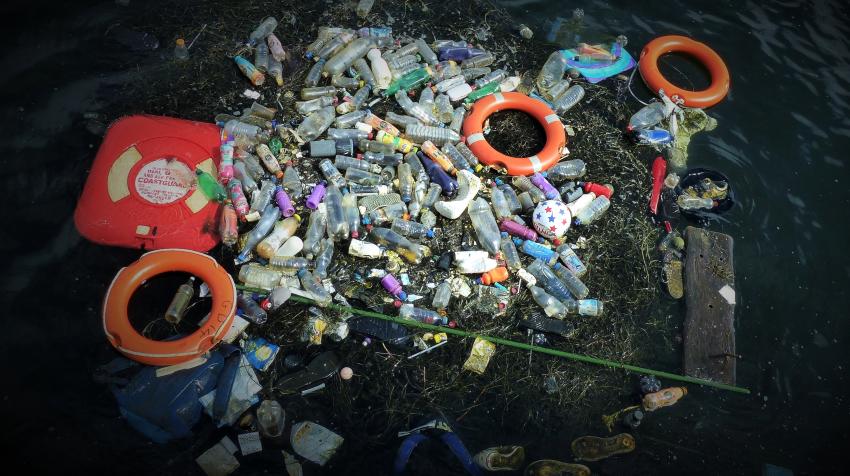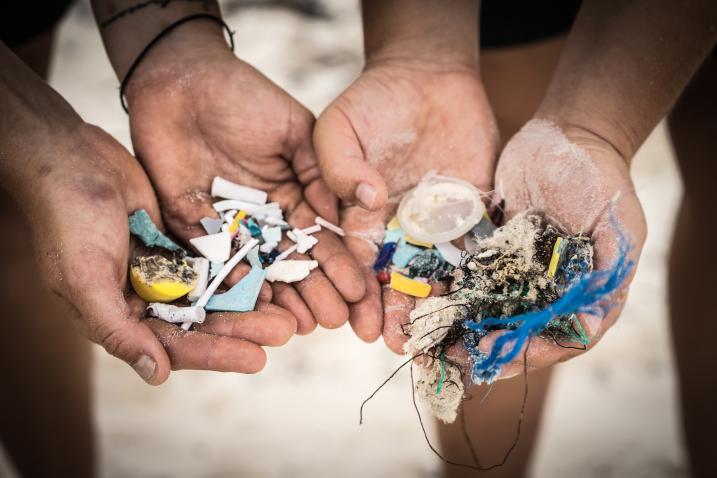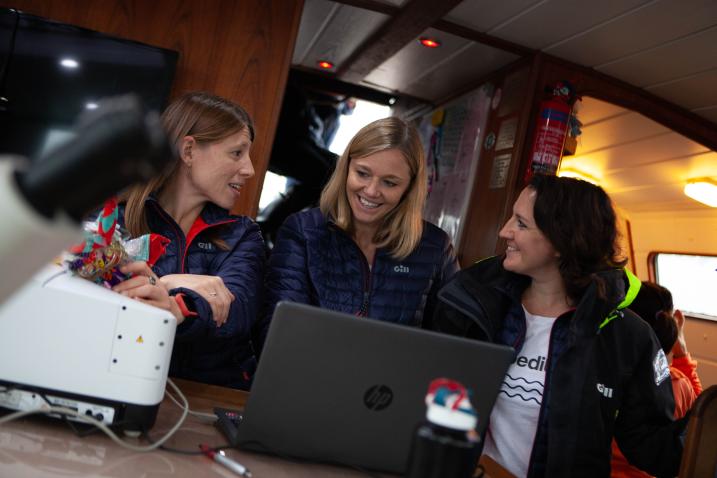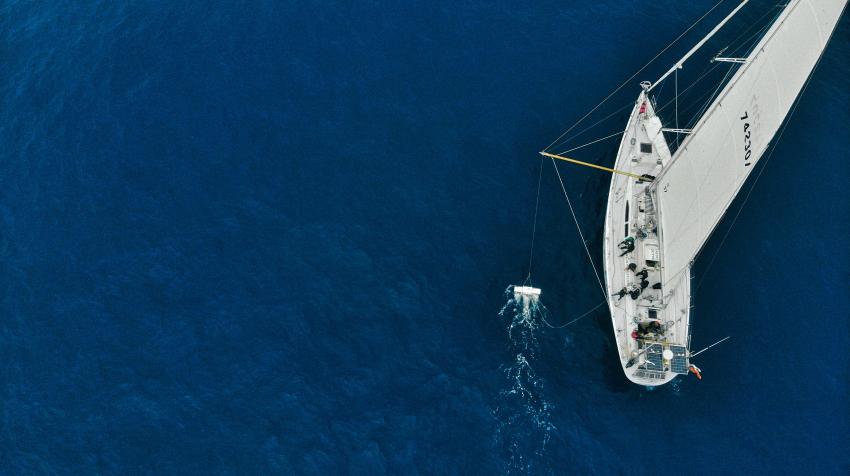28 June 2022
One of the things I love about being at sea is that you must constantly react to changes in the environment around you. If the wind picks up or the waves switch direction, you have to adjust your sails and shift your course. Sometimes your life depends on your response.
This idea of reacting and shifting direction has shaped how I’ve lived my life. One morning, during a journey around the world on a biofueled powerboat called Earthrace, I jumped over the side, mid-Pacific, for my daily wash. While in the water I saw a toothbrush, then a cigarette lighter and a bottle top. It didn’t make any sense—we were 800 miles from land!
This is what I like to call my “shift moment”—a point in time when everything changed for me and I couldn’t look back. It sparked a new career—leading sailing expeditions on a 72 ft research vessel called Sea Dragon, on a mission to understand the true problem of plastic pollution in our ocean and, ultimately, how we solve it. We visited many small islands to find communities struggling to catch fish and grow food due to pressures on their local resources. This led to a new reliance on imported food, which is often packaged in plastic. With nowhere for the waste to go it ends up on the beach, in the ocean or burned. I saw items made of plastic washing up on the shoreline with labels in languages I didn’t even recognize. In 2010, I set sail in search of the so-called “gyres” or plastic accumulation zones to find out more.

We went looking for “islands of plastic”, but we were surprised to find that plastic doesn’t just float around the ocean in big rafts. That would be something we could easily clean up. It was only when we dropped a fine mesh net across the surface of the water and pulled it on board that we realized what’s really there: hundreds, thousands, and what we now know to be trillions, of microplastics. We find them in every inch of ocean, right down to the seabed.
Sea creatures mistake these microplastics for food, which opens up a whole new series of questions. If plastic is getting into the food chain—our food chain—are toxic chemicals also collecting inside us? I decided to have my blood tested to find out what chemicals might be present in my body. We tested for 35 chemicals that are banned by the United Nations because they are known to be toxic to humans. Of those 35 chemicals, we found 29 in my blood.
I went on to learn about the impact those chemicals can have on people, particularly pregnant women, and that we can pass them on to our children. This is when, in 2014, we started eXXpedition—a series of multinational, multidisciplinary, all-women sailing voyages to explore solutions to plastic and toxic pollution from the equator to the poles.

It has become clear that microplastics are fairly impossible to clean up. Instead, we now have to ask ourselves how we can stop plastic from getting into the ocean—and into our bodies—in the first place, and essentially “turn off the tap”. If, through our scientific work at sea, we can identify what plastics are present in the ocean and trace them back to where they came from, we may also be able to pinpoint where the solutions lie.
Sometimes we find plastic at sea and the source is obvious or literally written all over it in a brand name or a country of origin. But most of the time, this plastic soup is so fragmented that it no longer resembles what it once was; it has become anonymous. So we work like detectives to pick up on clues that can lead us to the source.
We run the samples through our Fourier transform infrared (FTIR) machine, which determines the polymer type. Is it polyethylene terephthalate (the chemical name for polyester, also known as PET), which can be found in food packaging? Or polyamide fibres from our clothing? Or tyre dust shed from our vehicles when we go for a drive?
There is still a lot of analysis to be done, but the preliminary data is revealing some interesting facts. Polyethylene stands out, making up the majority of the plastic found in our samples. Polyamide and polypropylene are close behind. On one leg of our voyage, through the coastal waters of Antigua, a yachting haven, our analysis showed completely different results: we found paint fragments, acrylic and resins.

Our latest Round the World mission came to a halt with the arrival of COVID-19. The impact of the pandemic became apparent while we were halfway between Easter Island and Tahiti! We reacted by shifting our focus to creating change differently—at home, on our doorstep, where the problem begins.
Our research has shown that the sources of plastic pollution are endless; this means the solutions are, too. There is no silver bullet: We must tackle the problem from every angle. For many people, this message can feel overwhelming. Producers of goods might ask themselves if they should switch their packaging to biodegradable plastic, or glass, or paper, or if they need to redesign their products completely. Should I put a filter on my washing machine, or make clothes from bamboo, or should we rethink the way we sell clothing altogether? We know that we need all of these solutions and more, but many of us also require help to work out which measures to pursue and when.
In 2020, working in partnership with the software company SAP, we built an online platform called SHiFT.how, which is designed to help people and organizations consider hundreds of ways to tackle plastic pollution and find a good place to start. Users apply filters to help find solutions that are right for them, from simple consumer choices to more complex industry action. SHiFT.how has been used in 146 countries so far, and new solutions are added all the time.
Using technology in this way allows us to scale up our impact by making solutions accessible and relevant to a larger number of people, ultimately helping to drive change “upstream”. By getting businesses involved in innovating and implementing new and diverse solutions, we can build a circular economy and get closer to the source of the problem.
Plastic pollution doesn’t know political or cultural borders. We all share one planet, and global problems transcend all boundaries, which means the solutions need to as well.
For me, navigating a way through this global problem comes down to embracing diverse solutions; working across boundaries; and being prepared to grasp opportunities and adapt, which is what a decade at sea has taught me to do. We need to shift our sails and adjust our course as though our lives depend on it… because they do.
We don’t need everyone to do everything, but we need everyone to do something. It’s time to find your role. It’s time to act.
The UN Chronicle is not an official record. It is privileged to host senior United Nations officials as well as distinguished contributors from outside the United Nations system whose views are not necessarily those of the United Nations. Similarly, the boundaries and names shown, and the designations used, in maps or articles do not necessarily imply endorsement or acceptance by the United Nations.




